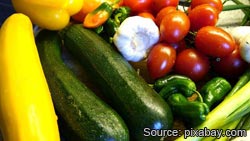
If you're new to vegetarianism, or are just in a veggie
burger and mac-and-cheese filled rut, you may be looking for some new ideas to
prepare delicious, unique and
healthy meals without meat. Contrary to popular belief,
becoming a vegetarian doesn't mean you have to lack important nutrients or
sacrifice your taste buds. Read on to find out how to prepare healthy veggie
meals you'll love to eat!
Get enough protein and vitamins
When becoming a vegetarian, it's
imperative to get a sufficient amount of protein and essential vitamins. While
meat and fish are major sources of protein, you can still consume healthy
amounts with a plant-based diet.
Protein needs vary based on your size,
gender, and activity level-further research and guidance from your
doctor/dietician is necessary to make sure you are receiving the required
amounts daily for good health.
Protein-rich vegetarian foods include:
- Legumes. Beans, chickpeas, green peas, peanuts, and
soybeans all fall under this category. Legumes are also important sources of
fiber and iron, and low in fat.
- Tofu. Made from fermented soybeans, tofu and tempeh are
often used as meat substitutes in vegetarian dishes due to the firm, chewy
texture that mimics the sensation of consuming meat. Tempeh has a higher protein
and fiber content, as well as more vitamins than tofu due to its fermentation
process.
- Nuts. Though often avoided due to high fat and calories,
nuts are a great source of protein and healthy fats in a vegetarian diet. Fat
intake usually decreases drastically on a vegetarian diet, and nuts are an
excellent source of the fat your body needs.
- Eggs (not consumed on a vegan diet). Eggs
are high in protein, and contain vitamin A, D, E and b12, zinc, iron and amino
acids.
- Dairy (not consumed on a vegan diet).
Dairy products, while sometimes high in fat, can be a good source of protein.
Greek yogurt is particularly high in protein per serving though low in fat and
calories.
Make vegetarian versions
If you have favorite meat-laden dishes
that you can't imagine never enjoying again, try to prepare them vegetarian! You
can sub vegetables for meat in almost any dish, and there are endless recipes
and ideas out there for you to try.
Some suggestions include:
- Fill fajitas or burritos with grilled veggies (peppers, onions, zucchini,
spinach, yellow squash, and eggplant) instead of beef or chicken
- Grill large portabella mushrooms rather than beef burgers to enjoy on a bun
with all your favorite toppings
- Going vegan? Make potato or macaroni salads with olive oil and spices rather
than mayo
- Love lasagna? Layer the pasta with braised roasted tomatoes and eggplant
instead of ground beef
- Make sloppy Joe's, meatballs, chili or stuffed cabbage with tempeh, veggies,
beans and rice instead of beef
- Use sautéed, marinated tofu cubes in stir fry or with rice and veggies
instead of meat, chicken or fish
- Top meatless pizza with assorted grilled veggies and roasted garlic-if
you're vegan, the creamy texture of the garlic is a great substitute for
cheese
Buy a cookbook
If you are a new vegetarian, a recipe book may
help you get started. Shop around for a beginner-friendly edition-many
vegetarian cookbooks feature highly complicated recipes which require a
seemingly endless list of ingredients. Check out online sources as well-there
are a variety of helpful vegetarian cooking tutorial websites available which
include recipes, tips, and meal ideas.
Prepare balanced meals
The best way to ensure your meal is
satisfying, nutritious and enjoyable is to keep it balanced. Make sure each meal
contains protein and fiber to keep you feeling full after you have finished.
Adding a variety of vegetables to each dish will provide your body with
essential vitamins and create an array of flavors to liven up your dish.
 Spice it up
Spice it up
If you are not a big fan of many
vegetables' tastes, switching to a vegetarian diet may leave you feeling
underwhelmed. Make your dishes exciting by adding bold flavors, zesty spices,
and exotic herbs. The right cocktail of seasonings can make the dullest dish pop
with flavor. Do you love spicy foods? Experiment with chipotle, paprika, curry,
and other spices that pack a punch. Prefer something sweet? Try adding basil,
tarragon, or even cinnamon for caramelized vegetables.
Contrast flavors and textures
Craft multi-dimensional meals by
combining contrasting flavors and textures. Mix sweet and spicy, firm and
creamy. For example, portabella mushroom burger, which is firm and meaty in
texture, would be perfectly complemented by a velvety yet pungent blue cheese
topping. Add texture to soft and creamy risotto with crisp asparagus and chewy
shitake mushrooms or tofu. Add nuts to pasta with slow
roasted/braised/caramelized veggies to provide a chewy crunchiness to an
otherwise silky dish.
Get creative
The best way to craft versatile, unique, and tasty
vegetarian dishes? Be creative! Experiment with new things-such as veggies you
have never tried, exotic spices and ethnic foods. Follow recipes, but add your
own spin on the meals. Taste as you go along and find out what you like and
don't like. Practice and experience makes perfect, and the more you cook
vegetarian, the more delicious your meatless meals will be.